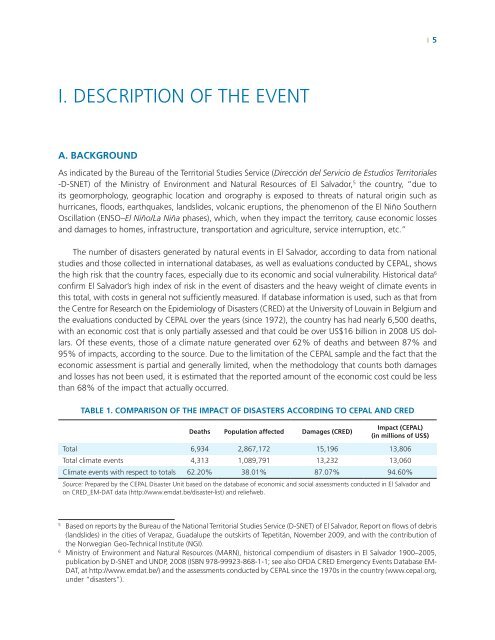El Salvador - GFDRR
El Salvador - GFDRR
El Salvador - GFDRR
Create successful ePaper yourself
Turn your PDF publications into a flip-book with our unique Google optimized e-Paper software.
| 5<br />
I. DESCRIPTION OF THE EVENT<br />
A. BACKGROUND<br />
As indicated by the Bureau of the Territorial Studies Service (Dirección del Servicio de Estudios Territoriales<br />
-D-SNET) of the Ministry of Environment and Natural Resources of <strong>El</strong> <strong>Salvador</strong>, 5 the country, “due to<br />
its geomorphology, geographic location and orography is exposed to threats of natural origin such as<br />
hurricanes, floods, earthquakes, landslides, volcanic eruptions, the phenomenon of the <strong>El</strong> Niño Southern<br />
Oscillation (ENSO–<strong>El</strong> Niño/La Niña phases), which, when they impact the territory, cause economic losses<br />
and damages to homes, infrastructure, transportation and agriculture, service interruption, etc.”<br />
The number of disasters generated by natural events in <strong>El</strong> <strong>Salvador</strong>, according to data from national<br />
studies and those collected in international databases, as well as evaluations conducted by CEPAL, shows<br />
the high risk that the country faces, especially due to its economic and social vulnerability. Historical data 6<br />
confirm <strong>El</strong> <strong>Salvador</strong>’s high index of risk in the event of disasters and the heavy weight of climate events in<br />
this total, with costs in general not sufficiently measured. If database information is used, such as that from<br />
the Centre for Research on the Epidemiology of Disasters (CRED) at the University of Louvain in Belgium and<br />
the evaluations conducted by CEPAL over the years (since 1972), the country has had nearly 6,500 deaths,<br />
with an economic cost that is only partially assessed and that could be over US$16 billion in 2008 US dollars.<br />
Of these events, those of a climate nature generated over 62% of deaths and between 87% and<br />
95% of impacts, according to the source. Due to the limitation of the CEPAL sample and the fact that the<br />
economic assessment is partial and generally limited, when the methodology that counts both damages<br />
and losses has not been used, it is estimated that the reported amount of the economic cost could be less<br />
than 68% of the impact that actually occurred.<br />
TABLE 1. COMPARISON OF THE IMPACT OF DISASTERS ACCORDING TO CEPAL AND CRED<br />
Deaths Population affected Damages (CRED)<br />
Impact (CEPAL)<br />
(in millions of US$)<br />
Total 6,934 2,867,172 15,196 13,806<br />
Total climate events 4,313 1,089,791 13,232 13,060<br />
Climate events with respect to totals 62.20% 38.01% 87.07% 94.60%<br />
Source: Prepared by the CEPAL Disaster Unit based on the database of economic and social assessments conducted in <strong>El</strong> <strong>Salvador</strong> and<br />
on CRED_EM-DAT data (http://www.emdat.be/disaster-list) and reliefweb.<br />
5<br />
Based on reports by the Bureau of the National Territorial Studies Service (D-SNET) of <strong>El</strong> <strong>Salvador</strong>, Report on flows of debris<br />
(landslides) in the cities of Verapaz, Guadalupe the outskirts of Tepetitán, November 2009, and with the contribution of<br />
the Norwegian Geo-Technical Institute (NGI).<br />
6<br />
Ministry of Environment and Natural Resources (MARN), historical compendium of disasters in <strong>El</strong> <strong>Salvador</strong> 1900–2005,<br />
publication by D-SNET and UNDP, 2008 (ISBN 978-99923-868-1-1; see also OFDA CRED Emergency Events Database EM-<br />
DAT, at http://www.emdat.be/) and the assessments conducted by CEPAL since the 1970s in the country (www.cepal.org,<br />
under “disasters”).
















